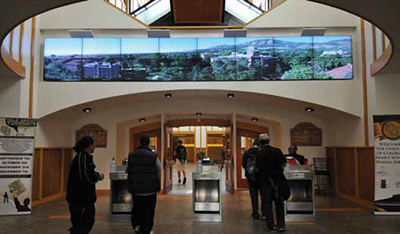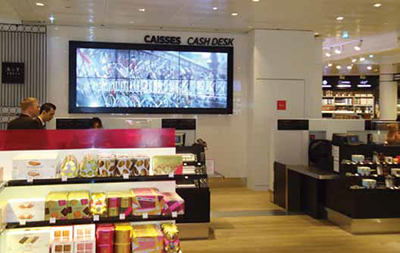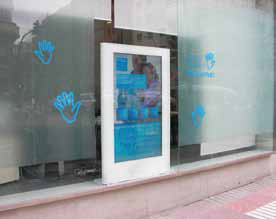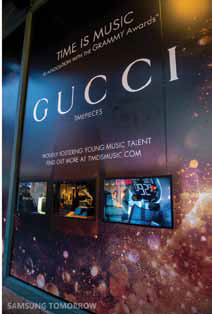Why Move Digital Signage Content to the Cloud?


Examples of networked digital signage in a convention center (left) and a retail setting (above, courtesy of Samsung). Steve Jobs often gets all the credit for blowing up the marketplace with the iPhone, most notably its cloud-based platform. But when you think about it, the average consumer has been managing their data in the cloud — or at least, in some version of it — long before the iPhone hit the stores. Through Hotmail, Yahoo!, Gmail and Amazon, we learned that not only is it pretty safe to store one’s critical personal information far away from one’s personal premises, it also renders access to that data, anytime, anywhere, easier and much more efficient.
- Arguably, however, it was the iPhone that drove businesses to explore what the cloud could do for them, and the answer is: lots. Advantages like a significantly decreased cost of ownership, low barrier to entry, simplified deployment, a monthly subscription model resulting in more predictable, streamlined budgeting, and a reduced need for on-site personnel to manage systems are attractive benefits to any organization’s number-crunchers. Digital signage solutions providers recognized this some time ago, pushing this technology toward what they would argue to be its inevitable destination: the cloud.
Digital signage, when designed with the user in mind, has the potential to transform interior spaces in shopping malls and retail centers, hospitality, and on campus.


For IT managers, the challenge is determining which solution is the best solution for their enterprise — a difficult task due to clutter in the marketplace, according to Raffi Vartian, chief operating officer for Signagelive, a cloud-based digital signage solutions provider headquartered in the United Kingdom, with offices in the U.S. “The fundamental part of digital signage is pushing pixels, and that can be anything from plugging a laptop into the back of a screen and running a website, and then having protocols back and forth to a website and then it appears on the screen,” he said. “The really, really hard part is all of the back-end systems to ensure that you have reliable networks and up-times. That’s the really, really hard part, but it’s so easy to disguise the fact that you can’t do that.” The result, he says, is that many organizations wind up with bad technology. “The reality is that there is so much churn in the marketplace as far as companies coming and going, and it’s really hard to get a consistent level of good business flow. So people get stuck.”
The shift to the cloud also has digital signage moving away from the PC, explained Minson Chen, business development manager for large format displays in Samsung Electronics America’s Enterprise Business Division.
“Enterprise customers used to deploy proprietary Windows PC-based client server solutions that required complex integration of discrete components” — such as content authoring software, a central management server and a player PC — “and a large team of IT and networking professionals to deploy and manage,” Chen said. Cloud-based digital signage enables companies to transfer this overhead to their vendors, who are increasingly offering full, turnkey managed services. Additionally, he points out, playback — such as that in Samsung’s Smart Signage products, which integrate system-on-a-chip technology — can now be embedded into the displays themselves.
Last year, Signagelive became one of Samsung’s preferred software providers for the Smart Signage line. Signagelive CEO Jason Cremins lauded the simplicity that cloud-based digital signage systems offer. “The installation is simple, and maintenance and support is simple,” he said. “It’s something that is very accessible to end-users, and it’s very accessible to non-systems integrators.”
Vartian adds that system-on-a-chip technology also reduces security risks. “When you go to system-on- a-chip, you’ve got an embedded operating system that can only do certain things,” he said. “The screen can only turn on, turn off, check the temperature — those kinds of things. The screen can’t do anything malicious to your network. Nobody can install anything. They’re not mining your security for personal information. It’s simply not possible because it’s system- on-a-chip technology.”
A daily selection of features, industry news, and analysis for tech managers. Sign up below.

Outdoor digital signage by Scala Right now, cloud-based digital signage adoption is largely depends on what industry you’re talking about: quick-serve restaurants, for example, are applying the technology for digital menu boards; retailers are also using it for display purposes. “Those folks are more interested in the cloud model because they have fewer concerns when it comes to things like internal data security,” said Maria Porco, vice president of business development at X2O Media Inc., a software and services provider based in Montreal, Quebec. “The business advantages of having the solution in the cloud and being able to scale quickly outweigh any other issues.” However, organizations in the financial, healthcare and defense contracting industries — companies that are highly regulated — aren’t as quick to move to the cloud.
Still, Porco notes, some of the more reticent organizations are taking “baby steps”: “Some companies are doing things like installing a private cloud, which is the same cloud concept, but it’s behind their firewall, within their facility,” she said. She adds that some companies are requesting hybrid solutions, whereby the content management software is cloud-based, but their data remains at their location.
Chen emphasizes that ensuring the vendor will provide adequate tech support is critical in addressing concerns surrounding cloud-based solutions. So too, he underlines, are service-level agreements. Corporate IT departments must also conduct their due diligence on the vendor to ensure that the network is secure, and that their data security policies are acceptable. “[The] network must be configured in compliance with corporate IT policies including white listing to restrict requests only from known sources, VPN, authentication, Active Directory/LDAP, etc.,” he said. IT managers must also decide whether or not the digital signage system should be on the corporate network, or a separate private network.
But as with everything in tech, issues surrounding security will eventually be resolved, and the financial case for cloud-based digital signage is too compelling for organizations not to make the shift, according to Vartian. “There’s only one conclusion to this story,” he said. “Everything is in the cloud.”
Are You In or Out?
Where there is digital signage, there must be content. The question is: do you handle it in-house?
“Creation and distribution of new digital signage content can potentially be immediate and on-demand with a solution that is managed in-house,” said Michael Lisi, regional manager at BP Marketing Group, a manufacturer’s representation firm headquartered in Savage, Minn. “There are typically lead times involved with having a third party create and update content for an organization.”
That said, is your company up for it? “It’s easy for organizations to underestimate the amount of time and energy involved in creating and continually updating meaningful content to their digital signage network,” Lisi said. After all, in order for it to remain captivating, it must be fresh, relevant and useful. “Once the content becomes stale, the attention it garners from the viewing audience and the effect it has on this audience rapidly declines. Many companies start off well but get worn out by the daily grind of producing content. In some cases, the quality level of the content continues to deteriorate until the organization decides to just turn off the monitors.”
Carolyn Heinze is a freelance writer/editor.
info
BP Marketing Group
www.bpmarketinggroup.com
Samsung Electronics America
www.samsung.com
Signagelive
www.signagelive.com
X2O Media Inc.
www.x2omedia.com
Gucci & Samsung Collaborated For Unique Macy’s Herald Square Display

Last year, Samsung’s digital transparent display solution helped show off the Gucci Timepieces & Jewelry collection. For the 2013 GRAMMY’s, Gucci Timepieces & Jewelry and Samsung teamed up to present a fusion of luxury fashion with innovative display technology. The Samsung NL22B LED LCD Transparent Display technology was used to showcase Gucci Timepieces & Jewelry’s GRAMMY special-edition watch collection in Macy’s Herald Square storefront windows. Samsung’s transparent LED-lit LCD display solution showed video content from Gucci Timepieces & Jewelry that played on and around the GRAMMY special-edition collection.
info
Gucci Timepieces & Jewelry
http://www.guccitimeless.com
Samsung Electronics
http://www.samsung.com
Carolyn Heinze has covered everything from AV/IT and business to cowboys and cowgirls ... and the horses they love. She was the Paris contributing editor for the pan-European site Running in Heels, providing news and views on fashion, culture, and the arts for her column, “France in Your Pants.” She has also contributed critiques of foreign cinema and French politics for the politico-literary site, The New Vulgate.
